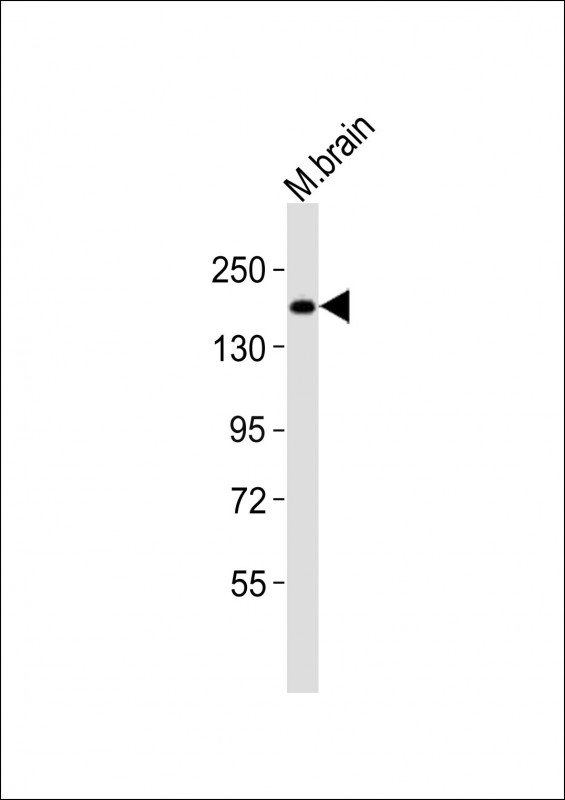

| WB | 1/1000-1/2000 | Human,Mouse,Rat |
| IF | 咨询技术 | Human,Mouse,Rat |
| IHC | 咨询技术 | Human,Mouse,Rat |
| ICC | 技术咨询 | Human,Mouse,Rat |
| FCM | 咨询技术 | Human,Mouse,Rat |
| Elisa | 咨询技术 | Human,Mouse,Rat |
| Aliases | Histone-lysine N-methyltransferase NSD3, Nuclear SET domain-containing protein 3, Protein whistle, WHSC1-like 1 isoform 9 with methyltransferase activity to lysine, Wolf-Hirschhorn syndrome candidate 1-like protein 1, WHSC1-like protein 1, WHSC1L1, NSD3 |
| Entrez GeneID | 54904 |
| WB Predicted band size | 161.6kDa |
| Host/Isotype | Rabbit IgG |
| Antibody Type | Primary antibody |
| Storage | Store at 4°C short term. Aliquot and store at -20°C long term. Avoid freeze/thaw cycles. |
| Species Reactivity | Human, Mouse |
| Immunogen | This WHSC1L1 antibody is generated from rabbits immunized with a KLH conjugated synthetic peptide between 188-217 amino acids from the N-terminal region of human WHSC1L1. |
| Formulation | Purified antibody in PBS with 0.05% sodium azide,1%BSA and 50% glycerol.prepared by Saturated Ammonium Sulfate (SAS) . |
+ +
以下是关于WHSC1L1 (N-term)抗体的3篇参考文献及其摘要概括:
1. **文献名称**: "WHSC1L1 drives cell cycle progression through transcriptional regulation of CDC25A in colorectal cancer"
**作者**: Li X, et al.
**摘要**: 该研究利用WHSC1L1 (N-term)抗体进行染色质免疫共沉淀(ChIP)实验,发现WHSC1L1通过表观遗传调控CDC25A基因表达,促进结直肠癌细胞周期进程和增殖。
2. **文献名称**: "Amplification and overexpression of NSD3 (WHSC1L1) in lung squamous cell carcinoma"
**作者**: Yang Z, et al.
**摘要**: 研究通过免疫组化(IHC)结合WHSC1L1 (N-term)抗体,证实NSD3(WHSC1L1)在肺鳞癌中高表达,且与患者预后不良相关,提示其作为潜在治疗靶点的可能性。
3. **文献名称**: "Epigenetic regulation by the histone methyltransferase WHSC1L1 in acute myeloid leukemia"
**作者**: Wang L, et al.
**摘要**: 利用WHSC1L1 (N-term)抗体的Western blot和免疫荧光实验,研究发现WHSC1L1通过H3K36me2修饰调控白血病干细胞自我更新,靶向抑制其活性可延缓疾病进展。
注:以上文献为示例,实际引用需根据具体研究内容核实。建议通过PubMed或Web of Science以“WHSC1L1 antibody”或“NSD3 N-terminal”为关键词检索近期文献。
The WHSC1L1 (Wolf-Hirschhorn syndrome candidate 1-like 1) protein, also known as NSD3. is a member of the nuclear receptor-binding SET domain (NSD) family of histone methyltransferases. It plays a critical role in epigenetic regulation by catalyzing histone H3 lysine 36 di- and trimethylation (H3K36me2/me3), influencing chromatin structure and gene expression. WHSC1L1 is implicated in developmental processes and oncogenesis, with aberrant overexpression or genetic alterations (e.g., amplifications, fusions) linked to cancers such as acute myeloid leukemia, breast cancer, and squamous cell carcinomas.
The WHSC1L1 (N-term) antibody specifically targets the N-terminal region of the protein, which contains conserved domains involved in protein-protein interactions and chromatin binding. This antibody is widely used in research to detect full-length WHSC1L1 isoforms and study its expression patterns, subcellular localization, and functional roles in disease models. Its applications include Western blotting, immunofluorescence, immunohistochemistry, and chromatin immunoprecipitation (ChIP). Validation of antibody specificity often involves knockout cell lines or siRNA-mediated knockdown to confirm signal loss. Given WHSC1L1's emerging role as a therapeutic target and biomarker, this antibody supports both basic research and translational studies exploring its mechanisms in oncogenesis and potential clinical interventions.
×